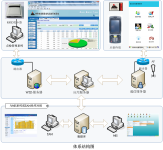
RFID equipment inspection management system
[ad_1]
background analysis
The main problems faced by traditional equipment inspection methods:
Insufficient acquisition of equipment status information: check with five senses, single information collection method, cumbersome, inefficient, time-consuming, and laborious paper and pen copying and input;
Equipment status information lacks effective description and circulation methods: written reports and oral reports mainly do not guarantee the accurate and timely transmission of equipment information; middle and high-level technical personnel and enterprise management personnel cannot understand the equipment status in a timely and accurate manner , To ensure timely maintenance of equipment failures.
The accumulation and sharing of equipment information cannot be realized: the expression of equipment inspection information is not unified and cannot be concentrated in time; a large amount of equipment history information lacks effective storage and management; equipment information is difficult to comprehensively use.
System Overview
The equipment inspection management system is a set of equipment inspection management system suitable for production enterprises, which is developed by adopting advanced safety management technology, radio frequency identification technology and mobile computing technology.
The system is composed of RFID electronic tags, handheld terminals (inspectors), handheld terminal systems and equipment inspection management systems. It can provide real-time feedback on the operating conditions of the equipment, automatically record equipment inspection results and other information, and timely produce equipment inspection statistics Analyze reports to facilitate middle and high-level technical personnel and enterprise management personnel to understand the equipment status in a timely and accurate manner. At the same time, the system fully considers the existing technical management level of production enterprises, and provides effective technical guarantee for the normal operation of enterprise equipment. At the same time, it improves equipment productivity and reduces equipment operating costs and maintenance costs.
System goals
1. Through the construction of equipment spot inspection management system, a new mode of monitoring, diagnosis and information management of equipment status spot inspection is formed;
2. In view of the problem that the spot inspection data is greatly affected by subjective factors and the data quality is poor, establish a spot inspection task mode to ensure the normal and effective progress of spot inspection and monitoring;
3. Aiming at the problem of poor applicability of traditional alarm setting methods, the system realizes the summary and analysis function of equipment inspection data, and provides effective support for formulating scientific and reasonable inspection plans;
4. The system realizes the notification function of equipment spot inspection abnormal data, timely feedback equipment failure information, and provides information prompts for equipment maintenance personnel;
5. Through effective spot inspection management, prevent the reliability of mechanical equipment from decreasing and the occurrence of failures, improve equipment productivity, and reduce equipment operating costs and maintenance costs.
System deployment diagram

Equipment inspection system platform function

Equipment check management terminal function

Main features of the system
Standardization of equipment inspection: standardize inspection cycle and scoring weight;
Standardization of equipment inspection content: Develop inspection standards for different equipment and standardize inspection content;
Efficient inspection process: The handheld terminal integrates reports, photographs, and wireless uploading, realizing paperless inspections, saving 50% of labor costs;
Informatization of inspection results: accurate and timely delivery of equipment status information, and real-time sharing of equipment status information;
Systematization of abnormal tracking: tracking the abnormal handling process and urging relevant personnel to deal with it in time;
Statistical analysis of abnormal conditions: Count the number and time of various abnormal conditions, and perform classification analysis;
[ad_2]



